12th Field Hospital Unit History

Partial aerial view of Camp Bowie Headquarters buildings.
Activation & Training:
The 12th Field Hospital was officially activated on 25 July 1942 at Camp Bowie, Brownwood, Texas, (Armored Division Camp; total acreage 116,264; troop capacity 2,237 Officers and 43,247 Enlisted Men –ed) and initially consisted of a cadre of 1 Officer and 24 Enlisted Men, all of whom came from Mitchel Field, Long Island, New York (already established in 1918 on Hempstead Plains –ed). The remainder of the year saw many additions of Officers and Enlisted personnel, the latter arriving for the most part from the MRTC at Camp Barkeley, Abilene, Texas.
During the month of September 1942, Lt. Colonel George J. L. Wulff, Jr., MC, assumed command, relieving Captain Sidney Dann, who came in as first CO with the cadre.
A number of EM made application for and were selected to attend OCS, a tendency which continued well into the year 1943. Newly arrived personnel from the MRTC were immediately incorporated into the unit and a program was begun to instill into all men the rudiments of military life.

Portrait of Lt. Colonel George J. L. Wulff, Jr., MC, Commanding Officer, 12th Field Hospital. The Officer had previously trained with the 21st General Hospital at Fort Benning, Georgia, and was eventually transferred to the 12th Field Hospital to become the unit’s new CO.
At the beginning, the unit functioned only for purposes of training Officers and Enlisted personnel from its activation date until the close of 1942. The organization was in compliance with T/O 8-510, dated 28 February 1942 and was divided into a Headquarters Company and three (3) identical Clearing Platoons (or Hospitalization Units) with an aggregate strength of 17 Officers – 18 Nurses – 211 Enlisted Men. During this period, individuals were given special attention due to the necessity for selecting men for key positions. Recreational activities were provided within the organization which greatly increased morale. By the end of 1942, Officer personnel had increased to 9 Medical Officers, 3 Dental and 1 Medical Administrative Officer, but Enlisted personnel was not up to authorized strength. Consequently, the new year ahead called for requisitioning of sufficient Officers and Enlisted Men to bring the unit up to the required personnel numbers. It was during these early months that all the Hospital Technicians and Orderlies received valuable training by being allowed to work in the Station Hospital at Camp Bowie. This type of training was continued into 1943 and proved an invaluable part of the overall training program during which the men concerned received not only group training but also individual instruction by Officers and Nurses of the departments concerned. Since basic training had been largely completed during 1942, field problems would now play a great part in the further training of the 12th Field Hospital.
The 12th was one of several Field Hospitals to be issued all of its medical equipment, and the early weeks of 1943 were spent in distributing all the impedimenta into 3 equal parts, one for each Hospitalization Unit. This was to allow the individual Platoons to function independently, and it was therefore imperative that when one of them was sent alone on a mission, that it have not only the necessary medical equipment to set up and operate a 100-bed Hospital, but that it also possessed the housekeeping supplies and material to support itself in the field. By the middle of February 1943 sufficient equipment had been received and repacked into Platoon quantities. Following distribution, it was considered desirable to obtain the practical use of this equipment in the field.
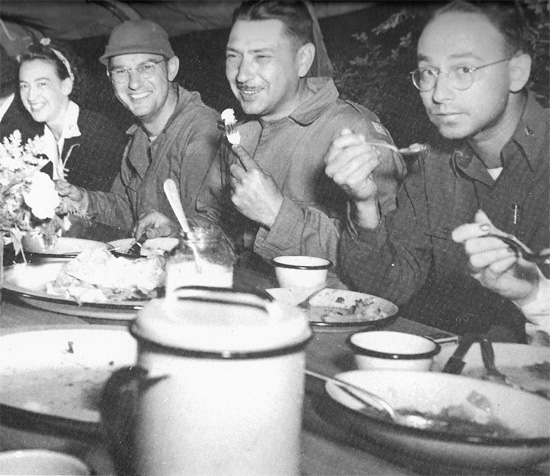
Members of Second Platoon, 12th Field Hospital enjoying a meal in the Mess Truck. Photo taken while bivouacking at Camp Bowie, March 1943.
From L to R: 2d Lieutenant Elizabeth T. Kramar, ANC; Captain Platt L. Allen, MC; Major Ernest A. Noone, MC; 1st Lieutenant Stanley Korp, MC.
On 22 February 1943, the entire unit moved into the field to set up the following installations under simulated combat conditions – Battalion Aid Station – Collecting Station – Clearing Station – and one-third of a Field Hospital. Personnel spent a portion of their time assigned to each installation so that they could become familiar with the various types of medical service supplied in the forward echelons during combat. One entire week was spent on this and a great deal of benefit was derived from the handling of equipment and personnel.
The 17 Nurses, exclusive of the Chief Nurse (First Lieutenant Claudia M. Draper, ANC, N-703058, joined the unit the latter part of March) assigned to the 12th Field, arrived from Billings General Hospital on 28 February 1943 by train under command of Second Lieutenant Freda M. Martin, ANC, N-728351.
As per Special Orders No. 26, dated 1 March 1943 and based on the provisions of Paragraph 14 (1) (a) Army Regulations 210-10, dated 1 July 1939, the following Nurses were assigned quarters at the Nurses’ Quarters, Station Hospital, Camp Bowie, Texas, effective 28 February 1943:
Second Lieutenant Eula M. Awbrey, ANC, N-728790
Second Lieutenant Gladys E. Detwiler, ANC, N-729072
Second Lieutenant Sevilla M. Durkop, ANC, N-728339
Second Lieutenant Elaine Henry, ANC, N-729303
Second Lieutenant Helen M. Horvath, ANC, N-728650
Second Lieutenant Ann T. Jackowski, ANC, N-729034
Second Lieutenant Elizabeth T. Kramer, ANC, N-728357
Second Lieutenant Mary J. Maegerlein, ANC, N-728416
Second Lieutenant Freda M. Martin, ANC, N-728351
Second Lieutenant Mildred J. Pickett, ANC, N-728810
Second Lieutenant Mary E. Schreiber, ANC, N-728420
Second Lieutenant Mary J. Taddei, ANC, N-728616
Second Lieutenant Florence E. Thompson, ANC, N-728890
Second Lieutenant Nola A. Thompson, ANC, N-728346
Second Lieutenant Isle R. Williams, ANC, N-729187
Second Lieutenant Irene L. Yeik, ANC, N-728404
Second Lieutenant Clara A. Young, ANC, N-728435
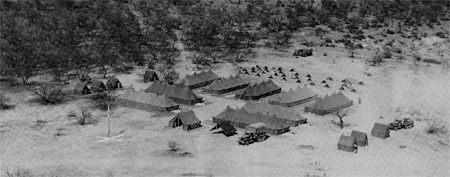
Aerial view of the 12th Field Hospital’s bivouac, Camp Bowie, February-March 1943.
It was felt that further value could be obtained by organizing field problems for the individual Platoons in order that they might spend more time handling the equipment and coordinating Nurses as fully part of the Platoon personnel (although it was SOP for Nurses to normally accompany the unit when assigned on a functional basis, they were never assigned on a training basis, so this was a change –ed); therefore, during successive weeks, beginning 15 March 1943, each Platoon spent a week in the field. Rain and wind added to the difficulties but taught many lessons that consequently improved drainage and sanitation issues. Another series of three 1-week periods, beginning 19 April 1943 were to follow with the focus being placed on camouflage and map-reading. Forced marches and hikes were included in the program as well, culminating in a 20-mile hike on 20 May 1943.
On 28 May, the unit was transferred to the Desert Training Center for combined operations, and set up at Freda, California. After being established in pyramidal and pup tents, the Hospital opened on 3 June 1943 and furnished station hospital coverage for troops quartered in the area until 21 June 1943. It was the 12th’s first operation, with patients, and under canvas. Many problems were encountered and solved and the resulting experience would later help during operations overseas. The organization participated in combined maneuvers in the desert lasting from 25 June to 17 July 1943. When authorizing combined transportation for the Field Hospital, it was found that the entire equipment and personnel could be moved on the following vehicles: 6 ¾-ton ambulances – 4 ¾-ton command cars – 1 ¾-ton weapons carrier – and 39 2½-ton trucks (fewer vehicles provided in the T/O & E). After completion of the maneuvers, the Hospital re-opened as a Station Hospital for only five days. It closed down on 28 July 1943.

Partial view of tent housing the Dental Officer’s den. From L to R: Captain Harold Thomasson, DC; patient; 2d Lieutenant Mildred J. Pickett, ANC.
The unit departed from the Mojave Desert area 13 August, arriving at Indiantown Gap, Pennsylvania (Training Center –ed), 17 August 1943 for a “period of straightening-out”. More Nurses joined and were equally assigned to Nurses’ Quarters at Indiantown Gap Military Reservation, effective 18 August 1943. Apart from the first group of ANC Officers, the following Nurses were also sent to IGMR: First Lieutenant Claudia M. Draper, ANC, N-703058; Second Lieutenant Vivian M. Robinson, ANC, N-735115; Second Lieutenant Grace R. Boggs, ANC, N-760515, and Second Lieutenant Eva D. Whittier, ANC, N-721894 (they replaced Elaine Henry and Clara A. Young, who left the group –ed).
Preparation for Overseas Movement:
Overseas Movement orders were received shortly thereafter, and all personnel and equipment were prepared in view of the readiness date. The unit proceeded almost at T/O strength to its overseas destination, transferring to Camp Kilmer, Stelton New Jersey, its Staging Area for the New York POE.
The 12th Field Hospital left the Zone of Interior on 12 October 1943 on the “Queen Elizabeth”. She was loaded with some 15,000 troops with all their equipment and heading for somewhere in Europe…
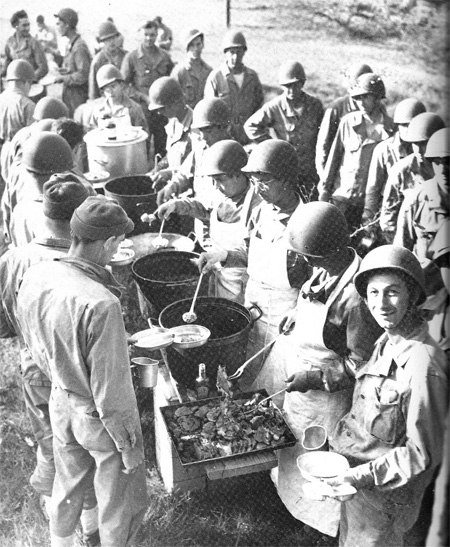
Partial view of Enlisted Men at Chow Line, Camp Bowie bivouac.
Once on board, days were filled with air raid and life boat drills. Abandon ship exercises were common just in case the ship was torpedoed or sunk. For many the food was awful, since totally English-style. Because of the ship’s movement and the horrible food, lots of people became nauseated and seasick. Showers had to be taken with cold seawater. An uneventful voyage, but a bad experience for most.
United Kingdom:
The “Queen Elizabeth” docked in Scotland, in the Firth of Clyde, 20 October 1943. The 12th Field was to be assigned to SOS, ETOUSA, at APO # 134, and instructed to open a Station Hospital for a period of about five (5) weeks until the permanent staff of this unit arrived from the United States. After this period, starting 27 November 1943, the organization was to go on inactive status pending further assignment, during which a rather extensive refresher training schedule, designed to raise the standards of proficiency, was launched.
Following debarkation, the organization entrained for a new, yet unknown, destination. Shades were drawn on the train during the journey until arrival. The 12th was located approximately five (5) miles northwest of Cardiff, Wales, in the vicinity of Rhydlafar, Glamorgan. The unit’s current strength consisted of 20 Officers – 18 Nurses – and 188 Enlisted Men.
After having been relieved by the advent of the 348th Station Hospital on 1 January 1944, the unit was now on inactive status, awaiting orders to move to a new location.
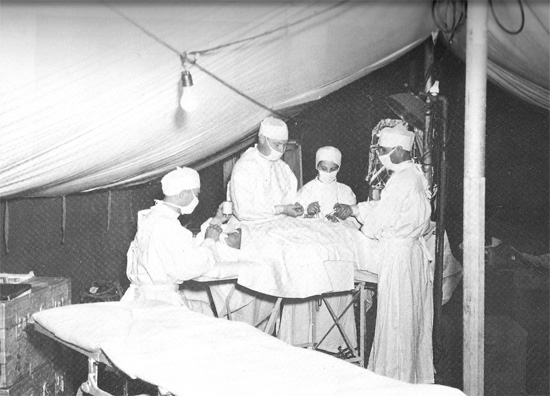
Partial view of OR in ward tent, Camp Bowie bivouac, March 1943. Standing: Captain Howard Pennings, MC, operating; and 2d Lieutenant Mary J. Taddei, ANC, assisting.
The next echelon in command was Western Base Section, United Kingdom, with Headquarters at Chester, England. Although being inactive, a vigorous training program, consisting essentially of road marches and calisthenics, was initiated to improve the physical well-being of each individual of the organization.
On 5 February 1944, per Movement Order No. 128, Headquarters Western Base Section, the unit departed by rail and motor convoy to Sussex for a new site. Personnel traveling by rail detrained at Haslemere, Surrey, where they were met by an advance party under direction of Major Ernest L. Noone, MC. The camp where they were to proceed to had previously been occupied by British troops. Upon arrival it was discovered that a major problem was that of providing heat for the EM’s quarters. All personnel at Fernhurst, Sussex, were housed in one-story frame buildings which in the end proved very comfortable and adequate. From 5 February to 7 March 1944, all personnel performed tasks incident to providing for more suitable living conditions in addition to carrying out their regularly assigned duties. At this location, they came under control of Southern Base Section, with Headquarters at Salisbury, England.
Early March, following VO received from the Surgeon, Southern Base Section, the organization was instructed to establish a tented Station Hospital for supporting nearby combat and service troops. It opened for receipt of patients on 8 March 1944. Pyramidal tents (in clusters of five joined units) were used instead of ward tents, which provided more hospital bed space and the use of fewer medical personnel.
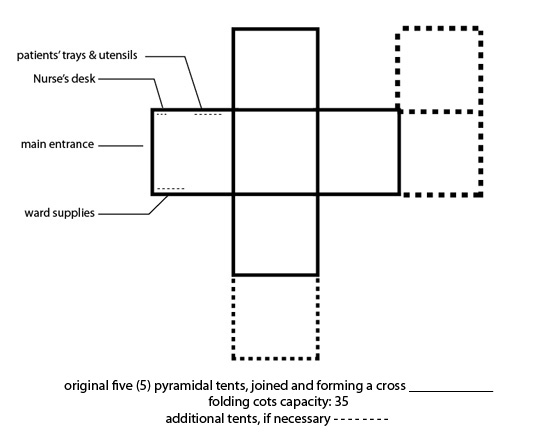
Recreational facilities were available; buses came by the camp at regular intervals enabling personnel to catch a train at Haslemere to visit places like London and other cities. Another facility was the local NAAFI canteen on the post which sold beer, sandwiches and cakes, and Special Services which provided movies and shows.
On 23 April 1944, orders were received to move to Weymouth, Dorset, which was reached on 27 April. Shortly thereafter, the 12th was assigned to ADSEC, ComZ, with Headquarters at Bristol for setting up a Holding Unit for non-transportable casualties returning from the D-Day invasion of France. The Hospital was to be established under tentage. The setup would include a centrally-located OR surrounded by twelve (12) wards. On 17 May 1944, the unit surgical setup was materially supplemented by attachment of 3 Surgical Teams under the direction of Major Ernest A. Maxwell, MC. These Teams consisted of 9 Officers – 3 Nurses – and 6 Technicians. In addition an Orthopedic Team was equally attached for a short time and also a Team for treatment of Gas Casualties. The majority of incoming patients were surgical cases, many in shock, and required the use of plasma, whole blood, and penicillin. A Blood Bank was therefore eventually attached to the Hospital. The first patients were not received before 9 June 1944, and their numbers proved less than anticipated. A preliminary triage took place at the unloading docks, after which the non-transportable casualties were brought to the Hospital by ambulances.
The cross-Channel evacuation program from France to the United Kingdom involved air evacuation (by the IX Troop Carrier Command) and sea evacuation (by a variety of ships, such as Landing Ship Tanks and British Hospital Carriers). For June 1944 the respective numbers were 6,469 (air) and 20,923 (sea); for July 1944, they reached 19,490 (air) and 18,195 (sea).
On 12 June 1944, the unit was ordered to have all equipment ready for rail shipment to Swansea by 15 June. After some discussions with higher Headquarters, the 12th Field was not closed until 22 June 1944. It was announced that the next movement would be to France. All vehicles and motor personnel were ordered to the Marshalling Area at Hursley, Hants., in the vicinity of Winchester on 20 June; followed by the remainder of the personnel who proceeding by rail, departed on 22 June. Upon arrival, everyone had to wait in the streets for over 2 hours until the necessary transportation arrived. The Nurses were billeted at the 46th Field Hospital some 12 miles away. Officers and EM were meanwhile cared for at the Marshalling Area proper. French Invasion Currency as well as some emergency items necessary for the Channel crossing were distributed, after which, adequate food, and movies provided for entertainment. After due processing, briefing instructions were given 24 June 1944 and final preparations made for departure. On 25 June, the organization proceeded to the Port of Embarkation at Southampton. 21 Officers and 159 Enlisted Men made the journey by motor convoy, with the Motor Officer and personnel remaining behind to board another vessel. Due to the confusion however, the Nurses were not there, and were to make the crossing in yet another vessel.
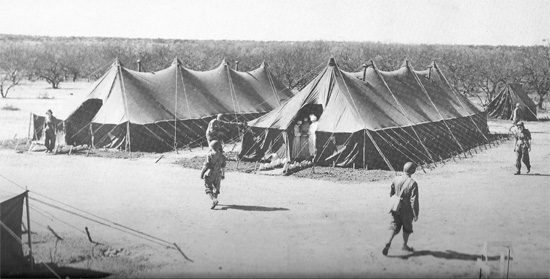
Another view of some ward and operating tents of the 12th Field Hospital. Camp Bowie bivouac, March-April 1943.
France:
On 25 June 1944, the Officers and EM boarded LCI 495 and experienced a pleasant voyage, arriving at Omaha Beach on 26 June 1944 at about 2400 hours (transfer of personnel and baggage to landing craft started at 2330 hours –ed). The 12th Field was one of the first ADSEC medical organizations to reach Normandy. After re-assembling at the Transient Area, everyone proceeded on foot to the assigned area to spend an extremely uncomfortable night in a steady rain. On 27 June, the organization moved to a nearby area, previously occupied by combat troops, where excellent foxholes were ready, and with plenty of blankets, K-rations, and hot coffee courtesy of a nearby Ambulance Battalion. The Nurses having arrived later were cared for in an Army Hospital. At 2400 hours, 28 June 1944, the Officers and Enlisted Men moved by motor convoy to the city of Cherbourg in vehicles borrowed from the 68th Medical Group, where they were to care for patients and eventually prepare the premises for later occupation by a General Hospital.
Cherbourg was reached in the early morning of 29 June and the 12th Field immediately assumed operation of a portion of the extensive French Naval Hospital. The installation (designated Hauptverbandplatz, Marine Lazarett –ed), a huge quadrangle built in the 1860s with flanking pavilions, was in indescribable chaos, and had been previously operated by Luftwaffe personnel, who had received many German casualties from the Allied drive to Cherbourg, including about 150 Americans, captured during previous operations. There were about 400 German patients still present, in virtually non-existent sanitary conditions (water system damaged –ed), and because of the lack of clear water, bedpans and urinals had been used again and again without cleaning. Furthermore, no attempt had apparently been made to provide for any form of laundry and filth was evident on the bedding and on the patients. A horrible stench emanated from these wards. Perhaps the underground operating theater presented the most ghastly scene; German Surgeons had been operating for a period of 72 hours non-stop and with water unavailable, had had no means to clean up the place. Blood, human debris from amputations, soiled clothes and bandages, were spread everywhere. Unburied bodies of dead soldiers and civilians had been dumped on the ground in the morgue and near the mess hall.

First-Aid Truck (field-converted 2 1/2-ton GMC version) pertaining to the 12th Field Hospital. Camp Bowie bivouac.
Ammunition, rifles, and gear lay among the dead, and throughout the building were heterogeneous collections of materials of war such as bloody clothing, helmets, shoes, weapons, and personal effects. There was but one thing to do: clean up the place! Floors were scrubbed and windows repaired, until all traces of the early disorder had vanished. The Germans cooperated satisfactorily and a system was worked out whereby the enemy Doctors, Nurses, and Enlisted Men cared for their own patients under the supervision of an American Medical Officer. This procedure was to remain in effect until the final evacuation of the Germans, thus making room for more American and Allied casualties, mostly resulting from land and anti-personnel mines and booby-traps left in the wake of the German troops. The attached Surgical Teams (who had not made the crossing with the 12th) joined the organization at Cherbourg on 1 July 1944. Overall medical service was efficiently administered by Major Harold J. Damstra, MC. Patients were subsequently transported by ambulance to Utah Beach, from where they were evacuated by ship to the United Kingdom.
While operating at Cherbourg, the unit not only served food to its own staff and personnel under the supervision of Lieutenant Walter F. Koster, but often provided housing and messing to personnel of 3 General Hospitals arriving from England and awaiting further deployment in the upper Cotentin Peninsula. A considerable amount of German medical supplies and equipment on the grounds, plus additional ones from the Hôpital Pasteur supplemented the own supplies so that no difficulties were experienced in maintaining an adequate supply of medical items. The Transportation Section under Lieutenant Roy C. Warner, MAC, only arrived in Cherbourg on 4 July and established themselves in some of the garages on the hospital grounds. Several German vehicles were commandeered, but were eventually turned in to Ordnance. One German 1 ½-ton Ford truck was withheld and converted into an improvised ‘mobile repair shop’ which proved its worth (although it to had to be ultimately turned in to the Ordnance Department –ed). The 5th General Hospital, still in bivouac and waiting for the Engineers to complete construction of its facility, detached surgical and shock teams and sent most of its Officers, all its Nurses, and about 100 Enlisted Men to the 12th Field to assist with cleaning and repairs at Cherbourg.
As the space provided for at the French Naval Hospital made it logically a site for a General Hospital, the plant was taken over by the 298th General Hospital which had landed on Utah Beach 15 July 1944. During this early period of continental operations ADSEC Headquarters were established at Catz, Normandy.
Before the end of July, the organization lost some of its Hospital Platoons, which were now to operate on an individual basis. The standard procedure was to quarter the Officers and the Nurses in pyramidal tents, while the Enlisted Men had to do with individual pup tents, which they attempted to make more habitable.
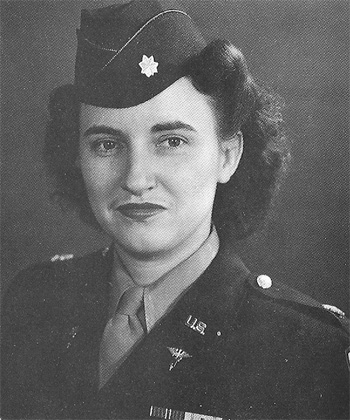
Photo of Major Claudia M. Draper, ANC, Chief Nurse, 12th Field Hospital. Captain C. M. Draper was transferred to the 164th General Hospital 11 February 1945.
Headquarters + Detachment “A”:
Headquarters Detachment and Detachment “A”, 12th Field Hospital arrived on 31 July 1944 from Cherbourg and set up at the same site (near Barneville –ed). Detachment “C” closed the Hospital as of 2359 hours, 1 August 1944, after admitting only 15 patients. Following further orders received 11 August from the Surgeon, ADSEC, ComZ, Headquarters and Detachment “A” moved to a new location in the vicinity of Avranches, France, where they were to function together with the 93d Medical Gas Treatment Battalion, as an Air Evacuation Holding Unit. They established a 200-bed unit including 3 wards, 1 operating room, a laboratory, and a pharmacy, all under tentage and located at the Air Strip. Det C” meanwhile remained at Barneville. Personnel strength consisted of 4 Officers + 20 Enlisted Men (Headquarters), and 6 Officers + 6 Nurses + 57 Enlisted Men (Det “A”), reinforced with 3 Officers + 1 Nurse + 2 Enlisted Men (the unit was to be designated 1st Advanced Section, Communications Zone, Air Evacuation Holding Unit –ed). The mission consisted in triage of patients to be evacuated by air to the United Kingdom. Detachment “A” was under the command of Major Platt L. Allen. On Thursday, 30 August, the other groups moved forward, leaving Detachment “A” to take over the administrative responsibilities of air evac, until the airstrip was closed (this took place on 1 September 1944, after the last 162 patients had been evacuated –ed).
Detachment “B”:
Following VO, Surgeon’s Office, ADSEC, ComZ, Detachment “B” was instructed to move to Valognes, France to establish a 134-bed station-type hospital for the Communications Zone Headquarters in France. The selected area was reconnoitred by Lt. Colonel George J. L. Wulff, Jr., CO, 12th Fld Hosp, Captain William A. Moore, and Captain Hyman Friedman, the same day. An advance party of 2 Officers and 17 Enlisted Men left Cherbourg by motor convoy on 31 July, arriving at the designated area at 1315 hours.
The main body comprising 14 Officers and Nurses plus 41 EM, departed Cherbourg railway station at 1000 hours and reached Valognes station at 1615, from where it entrucked for the actual hospital site. By 2000 hours, the tentage for personnel, the box latrines, and the kitchen were completed. Construction of the unit was effectively finalized, except for some minor details, by 1700 hours, 2 August 1944, so that Detachment “B” could open to receive patients the following day as instructed. The unit’s first patient was a French civilian. Several inspections by high-ranking Officers took place in the same period.
On 9 August 1944, 25 EM of the 127th General Hospital were attached for rations and quarters. They were relieved on 12 August. More inspection by Officers took place the following days. On 13 August 1944, 20 Enlisted Men of the 108th General Hospital were attached for rations and quarters and were relieved to return to their proper station on 16 August. Usual camp duties filled the days, with more VIP visits
Detachment “C”:
On 26 July 1944, Det “C”, 12th Field Hospital, commanded by Major Harold J. Damstra, MC, left Cherbourg at 1000 hours with equipment and personnel. 6 Officers, 7 Nurses, and 59 EM, loaded on their own vehicles, plus 17 additional vehicles borrowed from a QMC Truck Company. Their destination was a field 3 miles southeast of Barneville, France, where they arrived at 1200 the same day. The hospital site, still under construction, was laid out to contain a 400-bed capacity station type of coverage anticipating the arrival of the other two Hospitalization Units. Detachment “C” was to furnish medical service (capacity 134 patients) for troops returning from combat to the surrounding rest area (commanded by Colonel Ross B. Warren –ed).
The Detachment opened at 1200, 27 July. 33 Enlisted personnel of the 213th Quartermaster Laundry Platoon were attached per VOCO, ADSEC, ComZ in order to furnish laundry service for the Hospital. The very first patient was a Major Ross K. Peterson, followed by 4 more wounded. The number of admissions in August 1944 remained low, and apart from a number of American GIs included some French and Italian civilians. On 16 August, Major Charles Mahony, MC, EENT Consultant on DS with the organization returned to the 32d General Hospital. The Hospital Platoon closed as of 1159 hours on 30 August 1944. The adjoining rest area was closed on the same date. Remaining patients were transferred to the 32d Gen Hosp for further treatment.
After receiving new orders, Det “C” was instructed to move to a new site near Céaux, France. The advance party consisting of 1 Officer and 17 EM, with some equipment, and using Platoon vehicles plus 10 borrowed ambulances moved on 4 September 1944. The main body consisting of 8 Officers, 7 Nurses, and 43 Enlisted personnel followed by shuttle the next day. Usual camp duties continued in bivouac while awaiting the arrival of transportation, with some Officers returning from DS at the Granville Dispensary. Most equipment was packed and loaded before dusk on 16 September, and the next day, a party of 9 Officers, 7 Nurses, and 59 EM departed the Céaux area at 1020 hours, using a total of 15 trucks of the 93d Medical Gas Treatment Battalion plus 3 trucks and 3 ambulances of the 12th Field Hospital, as well as some from the 418th Motor Ambulance Company for carrying personnel and equipment of Detachment “C”, plus Headquarters supply (2 trucks) and personnel. They stopped at Le Bourget Airfield, near Paris, France, where the unit bivouacked.

Centerfold of Pamphlet and Guide illustrating the Indiantown Gap Military Reservation, Indiantown Gap, Pennsylvania. Training Center, acreage: 17,065; troop capacity: 1,440 Officers and 25,562 Enlisted Men. The 12th Field Hospital’s new station in August-September 1943.
The convoy left Le Bourget at 1000 hours, 18 September 1944, arriving at the location of Detachments “A” and “B”, near Cerfontaine, Belgium, at 1810.
During the above period, meals were adequate and satisfactorily prepared and served, bees presented much discomfort, and the rain and mud caused many difficulties in and around the camp site. Recreational facilities were provided in frequent trips to the nearby Mont St. Michel and the Brittany Peninsula, including the city of Rennes. In addition, Special Services provided movies and shows.
Because of the rapid advance of the Allied Armies, ADSEC Headquarters had moved far into France and the organization found itself no longer in ADSEC, ComZ controlled territory, so it was therefore relieved from assignment. Due to the spreading of the Hospitalization Units some confusion existed: Headquarters and Detachment “A” were still assigned to the Brittany Base Section; Detachment “B” was still at Valognes under control of Headquarters, Communications Zone. Detachment “C” was assigned to the Normandy Base Section. Consequently, the Office of the Chief Surgeon accepted the release of all 3 Platoons (or Detachments) from their various assignments and re-assigned the 12th Field Hospital as a whole to Advance Section, Communications Zone!
Belgium:
The Air Evacuation Holding Unit closed on 10 September 1944 and the entire unit proceeded to Cerfontaine, Belgium. The movement was by shuttle, moving a Detachment at a time, using a large number of vehicles pertaining to the 93d MGT Bn.
Headquarters and Detachment “A” began initial movement on 12 September, traveling through Paris, bivouacking the first night in an open field west of the city, and the second with the 28th Field Hospital in Reims. They reached Cerfontaine the next day in an area adjacent to the 9th Field Hospital.
Detachment “B” arrived at Cerfontaine, Belgium, 15 September 1944, followed by Detachment “C” on 18 September 1944.
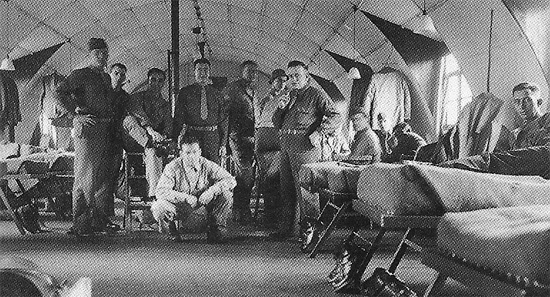
Partial view of Enlisted Men’s quarters when staying at Rhydlafar, Wales. Photo taken October-November 1943.
The 3 Hospitalization Units operated in conjunction with the 9th Field Hospital, another Air Evacuation Holding Unit setting up 8 wards, surgery, x-ray, pharmacy, and a pre-op and post-op tent (all pyramidal tents). An average of 350 patients were received per day, the majority of which were battle casualties. Total bed capacity was 600. Approximately 50% of these patients were evacuated to the United Kingdom and 50% to the Communications Zone. Under the direction of Major Platt L. Allen, Chief of Surgical Service, a shock and serious-ill tent consisting of 3 joined pyramidals, continuously arranged and equipped to do all kinds of dressings and administer plasma or whole blood, were established.
It rained a lot during the unit’s stay at Cerfontaine, turning the whole area in a sea of mud. Planes could not land and patients had to remain on litters for long periods awaiting air evacuation. Prisoners of War were also treated by the organization. They were assigned a separate section on the grounds. Weather conditions, overcrowded bed capacity caused tremendous messing and servicing problems, which called for some improvisation. After being helped for a short period by a mobile shower unit of the 9th Field Hospital, the 12th decided to set up its own unit in a squad tent (it had previously been well-used at Cherbourg and Barneville –ed). Living conditions for the EM were at times very bad due to the excessive rains, as they only had their pup tents to retire to.
On 26 September 1944, the entire organization moved to a new location near St. Trond, Belgium to operate another Air Evacuation Holding Unit in conjunction with the 93d Medical Gas Treatment Battalion. Their stay was to last 6 days. The installation was all under tentage and involved the same type of work as performed previously. The Hospital closed on 1 October 1944 as the 9th Army Air Force took over the airfield for tactical functions. The 12th Field simply moved to a bivouac site in a nearby apple orchard remaining there until 28 October with one exception. On 7 October 1944, Detachment “B” moved to Pépinster, Belgium to operate with Headquarters and a company of the 93d Medical Gas treatment Battalion a Railway Evacuation Holding Unit.
On 28 October, the unit (less Det “B” –ed) departed by motor vehicle with destination Hasselt, Belgium, to operate with A Company, 93d Medical Gas Treatment Battalion, a Railway Evacuation Holding Unit; its location was the new Caserne (a three-story brick structure), formerly used as a hospital by the Germans and currently occupied by British and American troops and components of the Belgian Army.
Operations began on 29 October and closed for receipt of patients on 10 November 1944, handling a total of 925 cases. The change that followed was due to modification of the respective American and British Sectors, with the British assuming control of Hasselt.
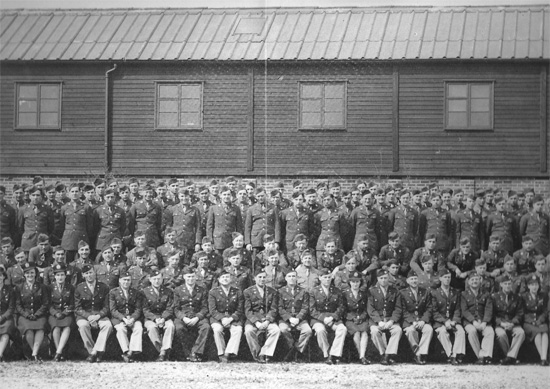
Partial photo illustrating personnel and staff of the 12th Field Hospital, Fernhurst, England, February-March 1944.
The Hospital then moved to the city of Herstal, Belgium, occupying the Collège Notre-Dame at St. Lambert. The organization did not function but simply bivouacked awaiting orders to begin further operations. Such was however not the case, caused by an increase in intensity of V-1 buzz-bombs flying over the area. On the night of 25 November one of these bombs landed so close to the 12th’s installation that it caused damage to the Detachment Headquarters resulting in injury to Captain Harold Thomasson, DC, who was OD at that time. After evaluating the risks involved, the EM moved to the basement of the school during November-December in order to be afforded better protection. The buzz-bomb activity climaxed when a V-1 caused a direct hit upon an adjacent gasoline dump on 17 December 1944.
During this period of inactivity at this location, the Surgeon’s Office, ADSEC, ComZ, requested the organization to furnish certain key personnel to medical units in nearby towns. Consequently, on 23 November 1944, 12 Nurses and 25 Enlisted Men were placed on TD with the 77th Evacuation Hospital. Other personnel occasionally supplemented the 28th General Hospital as well as the 130th General Hospital during the early days of the German counter-offensive in the Belgian Ardennes. With buzz-bombs continuing to drop in the immediate vicinity, it was realized that is was useless to expose personnel to such danger; consequently on 19 December 1944, the unit moved to a tented location one mile south of Vivegnis (north of Herstal), Belgium, where it set up a bivouac until 29 December (the move did not include Det “B” still at Pépinster, where it operated until 17 Nov 1944, after which it moved to Hollogne-aux-Pierres with the 93d MGT Bn to operate another Air Evac Holding Unit –ed).
The Nurses and EM who had been on TD rejoined the 12th on 30 December 1944. The Hospitalization Units did not return to their parent unit until after 31 December 1944. ADSEC started planning for the new campaign and certain installations were therefore re-grouped to provide backup for the anticipated Allied offensive. The 12th Field Hospital moved to Namur, Belgium where it opened a 900-bed Railway Evacuation Holding Unit to serve First United States Army Evacuation Hospitals.
On 1 January 1945, Headquarters Company, Detachments “A” and “C” were located on the west bank of the River Meuse, Namur, Belgium where it set up in the Hôpital Militaire. A 910-bed Holding Unit was established in order to primarily evacuate the battle casualties from FUSA Evacuation Hospitals located in the vicinity of Huy, Belgium. In fact the 12th functioned in different capacities, as a Field Hospital – a Station Hospital – and as a Holding Unit. Many of the wounded could remain at the Hospital since 400 of the beds were designated to function as a station hospital, and another 100 beds were reserved for non-transportable patients. A railway loading point was constructed by personnel of the 346th Engineer General Service Regiment (which had arrived in Belgium 11 Sep 1944 –ed) on a spur track approximately 300 yards from the Hospital. Additional manpower was furnished by attachment of A Company, 93d Medical Gas Treatment Battalion, supplemented by 2 Officers and 54 Enlisted Men of the 709th Medical Sanitary Company (Colored), and 7 Nurses from the 130th General Hospital. The personnel of the 709th Med San Co served mainly as litter bearers and much credit should be given to their CO, First Lieutenant Richard M. Stewart, Jr., MAC, who cooperated efficiently and to the fullest extent with all personnel of the Holding Unit.
The Hôpital Militaire at Namur consisted of one large building and five smaller ones. The large building was used as the Hospital proper and contained all surgical and medical wards, operating rooms, x-ray department, Nurses’ quarters, dispensary, messes, chapel, Enlisted Men’s quarters, and theater. Officers were housed in a two-story building adjacent and to the right of the Hospital proper, while Headquarters and its personnel was located in another smaller building near the Hospital main entrance. A smaller building in the back of the Hospital was utilized for supply and quarters for mess personnel. The garage held the motor pool, sufficiently large to shelter vehicles, trailers, and supplies.
The surgery was located on the first floor and consisted of small rooms ideally suited for pre-operative and post-operative patients. The operating room contained 3 tables. All litter patients were hospitalized on the first floor which consisted of 3 litter wards. They remained on the litters, upon which they were placed and transported to the Hospital; and merely placed on folding cots for preliminary treatment. As far as possible, all ambulatory patients were kept on the second floor. One ward was subdivided to care for 15 ambulatory Officer patients, 50 litter and ambulatory PW patients, and 74 American litter patients. All departments received a letter designation (e.g. B-1, or D-2, etc). The total number of patients evacuated by Hospital Train out of Namur between 1 and 22 January 1945, incl. was 5,491.
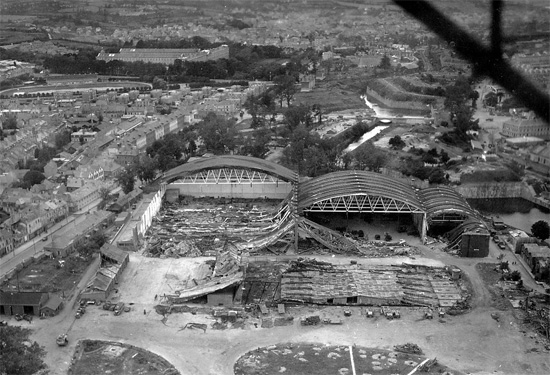
Partial view of Cherbourg. Top left in the background is the “Hôpital Maritime” (French Naval Hospital), surrounded by trees.
Due to the weather being very cold in January 1945, approximately 90% of the patients received suffered from either frostbite or trench-foot. Surgical cases however, were not received in very large numbers.
Germany:
Upon receipt of orders emanating from the Surgeon, ADSEC, ComZ, the 12th Field was to establish a 910-bed Railway Evacuation Holding Unit, at the Skt. Elisabeth Krankenhaus (also called Karin Göring Foundation) in the city of Aachen, Germany, and be ready to receive patients by 2400 hours, 10 February 1945. After a short reconnaissance, movement by motor convoy of equipment and personnel occurred between 7 and 9 February. Instructions regarding relations with the civilian population were in effect, and there was to be no fraternization!
The mission at Aachen consisted in evacuating casualties from the entire First and Ninth United States Armies sectors, and in order to accomplish such a task, some attachment of additional personnel was required. A Company, 93d Medical Gas Treatment Battalion, litter bearers of the 723d Medical Sanitary Company, and Nurses from General Hospitals in Liège, Belgium, supplemented the unit’s own personnel. The task was tremendous, but the 12th succeeded to officially open the filthy, debris-laden, eight-story building for receipt of patients on the requested date. There was ample space to quarter everyone, and install the necessary equipment and personnel. Additional quarters, mess halls, and storage facilities were established in some of the outlying buildings. D Company, 346th Engineer General Service Regiment was attached to the organization. Between 11 February and 4 March 1945, the organization treated over 10,000 patients; consequently, the personnel were sometimes required to work continuously for 48 hours or longer, hence the call for assistance.
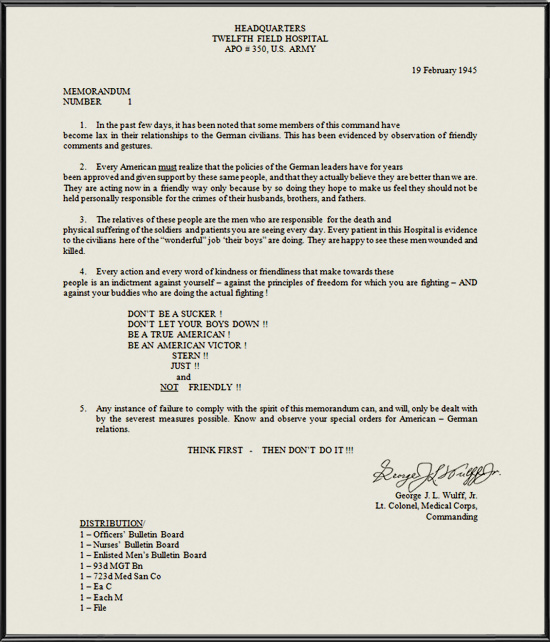
Copy of the 12th Field Hospital’s Commanding Officer’s instructions against “Fraternization with the Enemy”, dated 19 February 1945.
Because of the tactical situation, the number of patients received the first days was small. The planned offensive across the Roer River was delayed, with operations only starting 23 February 1945. This afforded the unit an opportunity to continue cleaning up the hospital premises. The very first Hospital Train to evacuate patients from the 12th Field Hospital left Aachen on 15 February, and following this first load, the numbers of patients coming in started to raise dramatically, reaching a peak on 3 March 1945. That same day, a total of five (5) Hospital Trains departed from Aachen all carrying patients evacuated from the hospital location, which totaled 1,482. A sixth Hospital Train was loaded at 0300 hours, in the early morning of 4 March 1945 (a total of 1,784 patients were admitted, triaged, and released as transportable during that time –ed).
The overall number of patients treated at Aachen, Germany, between 11 February and 4 March 1945, was 10,219, of which 7,900 were evacuated by Hospital Train. On many occasions, as many as 40 ambulances were waiting to unload which required the litter bearers to work continuously for periods of more than 48 hours. Sixty (60) or more major operations were performed in a 24-hour period. During the same period, a total of 637 surgical cases received operative treatment at the facility.
Because of the excessive large number of patients received, ADSEC decided it was necessary to set up another Railway Evacuation Holding Unit in the immediate vicinity. The site was Brand, Germany, in the Lintert Kaserne. Operations ceased at 2400 hours, 4 March 1945, and after turning over the entire medical installation to the 32d General Hospital, the organization started moving from Aachen to Brand on 6 March. Upon arrival they found a number of two-story buildings previously occupied by members of the 104th Infantry Division. As usual, the place was dirty and covered with much debris and litter. Many of the buildings were without windows and much repair had to be done to provide for a decent operation. F Company, 346th Engineer General Service Regiment began immediately to install blackouts, repair windows and roofs, and check water and electricity. A large generator was secured to furnish power and light for the entire installation.
The Hospital unit opened at 0001, 8 March 1945. As had been done before, additional personnel were secured to supplement the 12th. Eight (8) Medical Officers from the 77th Evacuation Hospital, Nurses from General Hospitals stationed in the Liège area, Belgium, and litter bearers from the 709th Medical Sanitary Company were attached for duty.

Nurses of the 12th Field Hospital during training at Camp Bowie, Texas. From L to R: 2d Lieutenant Nola A. Thompson; 2d Lieutenant Sevilla N. Durkop; and 2d Lieutenant Mary J. Maegerlein. Photo taken 15 March 1943.
The total number of patients evacuated by Hospital Train out of Brand, Germany between 10 March and 9 April 1945, incl. reached 4,814.
Personnel Assigned & Joined 12th Field Hospital
1 MAC Officer (from 29th Infantry Division)
2 ANC Officers (from 16th General Hospital)
1 ANC Officer (from 77th Evacuation Hospital)
1 Private First Class (from Headquarters, ASCZ)
1 MC Officer (from 231st General Hospital)
1 Private First Class (from 231st General Hospital
Personnel Transferred from 12th Field Hospital
1 ANC Officer (to 178th General Hospital)
1 ANC Officer (to 164th General Hospital)
4 Privates (to 6960th Reinforcement Depot)
1 ANC Officer (to Headquarters, Twelfth Army Group)
1 Private + 6 Privates First Class (to various medical organizations, incl. 14th Field and 32d General Hospitals)
2 ANC Officers (to 1st General and 56th General Hospitals)
1 MC Officer (to 83d Field Hospital)
1 Technician 5th Grade (to unnamed continental Hospital)
1 Private First Class (to Reception Station # 7, Ft. Sheridan, Illinois)
2 Privates First Class + 1 Technician 3d Grade (to 15th Reinforcement Depot)
The Hospital at Brand closed 9 April 1945 and preparations made to move further into Germany at a location yet to be designated. The Commanding Officer made a reconnaissance trip to Drensteinfurt on 12 April, but this site was changed almost immediately. The next site was to be an Airstrip near Hildesheim, Germany, for the special purpose of establishing an Air Evacuation Holding Unit for receiving, providing treatment, and evacuating RAMPs (Recovered Allied Military Personnel –ed). Advance personnel were quartered in the military barracks in Hildesheim, but later moved to a tented setup near the Airstrip. All personnel began the move on 15 April, completing it on 19 April 1945. The total bed capacity at this date was 600. The 12th Field was now assigned to Ninth United States Army.
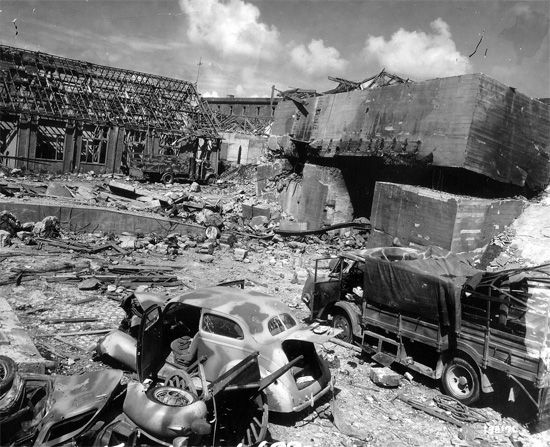
Partial view illustrating the Cherbourg Arsenal after the German surrender 29 June 1944. Photo of the destructions taken early July 1944.
The experience was entirely different and new because of the type of patients received. These men had undergone in many a case a long period of slow, suffering starvation, and therefore needed special treatment. Many of them were so emaciated that they had to receive limited amounts of food. The greatest difficulties encountered at Hildesheim were the continuous rain and the lack of mail which affected morale. The mail problem was solved after a visit to the Base Army Post Office at Liège, Belgium, but the mud continued to cause much trouble until the Engineers alleviated the situation by building some gravel roads through the hospital area. More plans to move were cancelled. Meanwhile the patient load was building up as the aircraft could not land because of the adverse weather conditions. On 7 May, air evacuation took off again due to favorable weather conditions; and from that date on until 11 May, evacuations occurred almost daily.
On 11 May 1945, Headquarters ADSEC, ComZ, requested that two (2) Platoons be returned to Brand to operate a 3,000-bed PW Hospital. It was understood that the 63d Field Hospital would take over from the 12th (except for one Platoon which would remain at Hildesheim to continue receiving RAMPs until such time that the 63d Field could be completely ready –ed). On 14 May, First and Second Hospitalization Units began the move to Brand, arriving there the same day. The next few days were spent cleaning up the entire installation with the help of PW labor from an adjacent enemy PWE. Three buildings were to be used by the organization, with a separate building to be utilized by the Germans as a mess for the patients, Officers and Nurses. German Enlisted Medical Corps personnel were quartered in a separate group of buildings behind the hospital. While the organization was to run a 3,000-bed PW Hospital it did neither have the necessary personnel nor the utilities to adequately handle and care for the PW patients and personnel concerned. Unable to secure additional manpower from the numerous PWEs in the Rhineland area, the problem was finally solved by the Surgeon, Headquarters, ASCZ. During this period, the 12th scrounged for any possible kitchen equipment, cutlery, and supplies, and secured 40 German Medical Officers, 21 German Nurses, and 250 German medics. Receiving both American and enemy wounded, the patient load rapidly increased up to approximately 2,500 by 21 May. Consequently 12 EM from the 561st Motor Ambulance Company were attached to assist with receiving and evacuating patients. With such a large number of enemy Prisoners of War present, the problem of guarding them became paramount. Eventually barbed wire was strung around the rear part of the Hospital and in some strategic locations. Armed guards were supplied by the 709th Med San Co.
On 26 May 1945, instructions were received from Colonel Charles H. Beasley, MC, Surgeon ASCZ (Advance Section, Communications Zone), to discharge the PW patients to civilian life, after they had all been carefully screened by CIC personnel. On 28 May, a CIC Team of 1 Officer and 5 agents arrived for the purpose; it completed its work on 29 May, releasing only 18 PWs to civil life.
On 30 May 1945,the First Hospitalization Unit (Det “A”) under command of Major Platt L. Allen, MC, departed by motor convoy to Koblenz, Germany, having received orders to establish hospital coverage for a PWE located in the area.
France:
The period of inactivity did not last long as instructions were received on 20 June to prepare the entire unit for a move to Reims, France, with the mission to operate at Airstrip A-62 (3 miles north of Reims, constructed by the 850th Engineer Aviation Battalion 30 August 1944, mainly used as an air evacuation and re-supply airfield, operated by the Ninth US Army Air Force –ed) another Air Evacuation Holding Unit. The organization’s Commanding Officer flew to Reims on 21 June to confer with the Surgeon, Oise Intermediate Section, about the new mission. Although contemplated to move by motor convoy, the plans were changed as the necessary trucks were not available. The organization therefore moved in three groups; supply personnel and supplies by one (1) train; mess personnel, Headquarters personnel, Nurses, and a number of Officers by motor convoy; and the remainder of the unit by another train. Movement of the entire 12th Field Hospital was finally completed on 30 June 1945, after much delay of the train carrying the bulk of the equipment. At the new location, preparations were made to set up a 400-bed Air Evacuation Holding Unit. Existing buildings were utilized for mess, supply, and Headquarters. The 196th and 197th Motor Ambulance Detachments were attached, and 48 EM in total joined the organization on 28 June 1945.
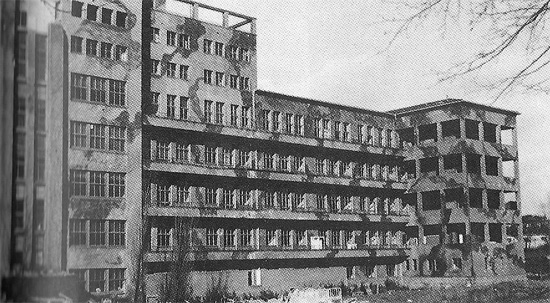
Partial view of the camouflaged buildings of the “Sankt Elisabeth Krankenhaus”, Aachen, Germany. Photo taken February 1945.
While serving at this new site, recreational facilities, including furloughs and leaves to the French Riviera and to England, and 72-hour passes to Paris, Brussels, and Liège were common. After arrival at the Airstrip, a physical inspection was held to eliminate VD in the organization. A daily physical program of 15-minutes of calisthenics was introduced. I & E classes were held on a weekly basis with an excellent attendance rate. Five (5) men were transferred to other organizations; and only one (1) EM was assigned to the unit. Forty-eight (48) personnel from different units were attached for TD. Three (3) EM were subjected to Company punishment; and two (2) Enlisted Men were reduced in grade for delinquencies. Overall unit strength on 30 June 1945 was 172 Officers – Nurses – and Enlisted Men.
(the authors did unfortunately not discover any information relating to the last operations conducted by the 12th Field Hospital in the ETO, prior to its return to the Zone of Interior).
Late War Operations:
As of 26 October 1945, USFET published following Letter AG 323.3 MCH-AGO, listing the official opening dates for a number of Hospitals, including the 12th Field:
Detachment “A”, 12th Field Hospital with a 250-bed capacity, opened in the Hospice Civil, Le Mans, France, APO 562, at 0001 hours, 20 October 1945 (the unit took over the site formerly operated by the 38th Sta Hosp).
12th Field Hospital, less Det “A”, with a 250-bed capacity, opened in Charleroi, Belgium, APO 562, at 0001 hours, 20 October 1945 (the unit operated the site previously occupied by the 160th Sta Hosp). It closed for the reception of patients at 2400 hours, 26 November 1945.
On 27 November 1945, USFET announced the opening and closing of US Army Hospitals, including the:
12th Field Hospital, less Det “A”, with a 250-bed capacity, opened in the Citadelle, Liège, Belgium, APO 562, at 0001 hours, 1 December 1945 (the unit operated the site previously occupied by the 91st Gen Hosp).
Personnel Roster:
| Officers & Enlisted Men: (incomplete) | |
| David R. Alarcon | José A. Aldama |
| Clermont C. Allen | Platt L. Allen, Maj, MC |
| Arnold A. Anderson | Elder C. Anderson, Capt, ChC, O-542993 |
| Paul Aragon | Harold R. Arebaugh |
| Charles O. Arkin, Sgt | Edward J. Baird |
| Paul A. Baker, Tec 4, 39178453 | Obie T. Baker |
| Hasel Balentine | Roby C. Barnard |
| James T. Barnett | Leslie Bates |
| John A. Bearshears | George W. Benson, 1st Lt, MAC, O-1547232 |
| Carl E. Bergman | Seymour C. Berschling |
| Arthur H. Beske, Capt, DC, O-526035 | Leonard W. Bierfeldt, Sgt |
| Louis F. Bierman | John K. Birmingham |
| Verlyn B. Bolin | Ray W. Booth |
| Elmer J. Borman | Attilio Borrelli |
| Herman F. Brisco | Louis R. Brizzolara, T/Sgt, 36600336 |
| Thomas L. Brookshire, Tec 5, 38203186 | Stanley P. Bullard |
| John E. Burg | Stanley F. Burk |
| Herman L. Butter, Pfc, 38185818 | John S. Cambell, Capt, MC, O-435907 |
| Percy J. Cambre |
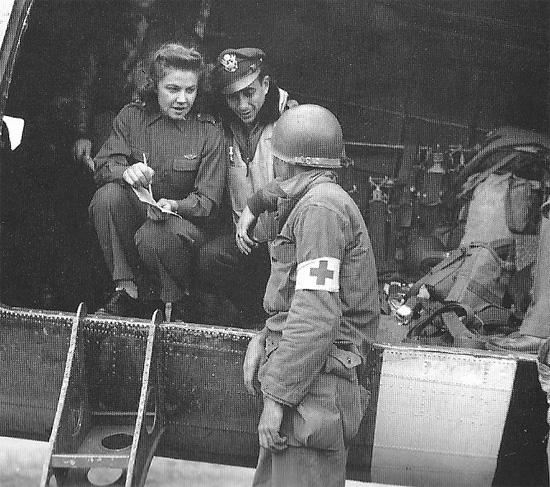
Flight and medical personnel discuss planning before taking patients on board for evacuation to the rear. Picture taken while the 12th Field Hospital was operating as an Air Evacuation Holding Unit in France. Taken August-September 1944.
| Henry L. Card, Pfc, 36180547 | Gilbert W. Carlson, Jr. |
| Willard Carpenter | Willard C. Carrey, Sgt, 38111890 |
| Javan L. Carroll, Jr. | Grover S. Carter |
| Kenneth L. Carter | William J. Caruso |
| Hipolito H. Castillo | Charles L. Cavanaugh |
| Alvin M. Ceretto | James D. Chapman |
| Elgie J. Chely | William J. Chene |
| Edmond O. Chevalier | James W. Chisholm |
| Dominic Ciccarelli, Pfc, 33192736 | Patsy A. Cirillo, Tec 5, 32611420 |
| Alvae Clark | Ernest M. Clark, Tec 4, 35577794 |
| Wallace C. Clark | Kenneth D. Cole |
| James E. Cover, 2d Lt, MAC, O-2007920 | Edward D. Coyle |
| William E. Crandall | Texford E. Crouch |
| Samuel J. Crouse, Pfc, 32837919 | Willard C. Currey |
| David E. Curtin | Ralph J. Cyganiak |
| Lloyd J. Dahlheimer | Harold J. Damstra, Maj, MC |
| Arthur M. Daniel, Jr. | Sidney Dann |
| Jasper L. Davidson | William R. Davidson |
| David H. Davis | Tony A. DeCinque |
| Anthony F. DeFrancisco | Benjamin DelGiorno |
| Joseph C. Delingo | Milton H. Dieck, ,Tec 5, 38317510 |
| Jack Diener, Capt, DC, O-545352 | John L. Directo |
| Emil W. Divin, Jr., Pvt, 38113110 | Marvin M. Dix |
| Paul G. Dorn | Elliott Dribbon, |
| Benjamin Dubrow, 1st Lt, MC | Delbert R. Duck, Pvt, 33570797 |
| Sam Edlavitch | Theodore R. Embach |
| John E. Emmanuelson | Stephen W. Engel |
| Douglas Epstein, Capt, MC | Manuel C. Espinoza |
| Raymond F. Fabian | Douglas S. Fairbanks |
| Charles W. Felt, Capt, DC, O-525943 | Eugene A. Fierro |
| John J. Fink | Leon C. Finnegan, Pfc, 31060535 |
| George S. Folckemmer | Tony B. Forrester |
| Homer Foster | Burce H. Fowler |
| Melvin Fox, Capt, DC, O-1717418 | Robert S. Freedman |
| Hyman Friedman, 1st Lt, MC, O-1689398 | Harry W. Froehlich |
| Robert M. Frye, Pvt, 34311578 | Alson J. Fullbright |
| James B. Fulton | John J. Funfare, Pfc, 20320627 |
| Wayne Gandy | Ignacio E. Garcia |
| Remo E. Gay | Bernard F. Gibbons, Tec 3, 31097381 |
| Richard L. Gibbons | Abraham Ginsberg |
| Solomon E. Gittleman | George B. Gleason, Jr., Pfc, 35766079 |
| Albert L. Graham | Innis W. Graves |
| Emory C. Gray | Charles A. Gritta, Pvt, 20345823 |
| Gilberto Guerrero | J. W. Guinn, Pfc, 382130871 |
| Matthews Halligan, Pfc, 38105227 | Adolf E. Harer, 1st Lt, MC, O-470189 |
| Elbert H. Hargis | Gracchus C. Harris |
| Joe S. Harris | Devert W. Hastey |
| Wallace E. Held, M/Sgt, 33687232 | Gilbert Henderson |
| Carter J. Higgins | Howard Hill, 1st Lt, MC |
| Lee A. Hill | Joe L. Holley |
| Charles T. Hoppie | Mathias J. Hoven, Jr., Pfc, 37368749 |
| William J. Humphrey | Heinline G. Hunt |
| Cornelius A. Hurley, Jr. | Benjamin Jacobs |
| Alvin Jacobson | Clarence F. Jenkins |
| William E. Johnson, Jr. | Harold E. Jones, Sgt, 18193365 |
| Ira G. Jones, Jr. | John J. Juavinett |
| James R. Keeton, 1st Lt, MC | James H. Kenney, Jr. |
| Jim T. Kirby | Stanley Korf |
| Walter F. Koster, 1st Lt, MAC | Joseph J. Labak |
| Paul L. Lane | Raymundo Lara |
| Thomas A. Laub | Alfred M. Leeman |
| William E. Leigh | Joseph B. Lewandowski |
| Richard J. Leyerle, 1st Lt, MAC | Arthur N. Lindgren, 1st Lt, MAC, O-1545724 |
| Edward L. Linn | Alfred F. Loewenhagen |
| Donald C. Long | Samuel E. Lowery |
| Theodore S. Lyle | Marion A. Macomb |
| James E. Malloy | Ollie Manetta |
| Pietro Marini, Pfc, 36338578 | Jerome Mark, Capt, MC, O-491972 |
| John A. Martin | Carl L. Massey |
| William J. Matherly | Nels Matson |
| Fulton O. McCormick, Pfc, 34580113 | Joseph M. McDermott |
| Joseph F. McGorry | Harold M. McGreevey, Capt, MC |
| Clifton D. McMahan | Thomas L. McMain, Pfc, 38185838 |
| William R. McNabb, Pfc, 38396087 | Edwin J. McNulty |
| Alfred P. Melleby, Jr., Pvt, 32699936 | Donald Mertz, Pfc, 32949212 |
| Arthur D. Miller | Benny Miranda |
| Berry W. Monk | William A. Moore, Maj, MC, O-381188 |
| Stuart F. Moser | Harry B. Moserman |
| Chu W. Mow, Pfc, 32719869 | Henry B. Mulhern |
| Robert L. Myers | Charles S. Naimo, Pfc, 32593745 |
| Arthur F. Najamy, Pfc, 31051567 | Arthur D. Needles |
| Harry J. Nelson | Elie Newman |
| Charles C. Nieman, Pfc, 32611663 | Ernest H. Noerenberg, Pvt, 32593302 |
| Ernest A. Noone, Maj, MC | Ned S. Ochocki |
| Sam A. Oddo | Billy E. Oliver |
| Herbert N. Oliver | L. J. M. Oliver |
| Walter F. Olson | Jack D. Palmer, Pvt, 38233410 |
| Louis V. Palumbo, Pvt, 12207791 | Milton F. Paradise, Pfc, 33226798 |
| Thomas A. Parkerson | Frank P. Paternoster |
| Glen W. Payne | Robert H. Peach |
| Clyde Pease, Jr. | Otto Peeler |
| Sova Peluzzo | Howard Penning, Capt, MC |
| Abraham M. Peskin | Robert J. Phelan |
| Kenneth M. Philpot, Tec 5, 35701053 | Rile E. Pierce |
| Adolph C. Pietranowicz | Angelo Pignato |
| George W. Pittman | Forrest T. Plass |
| Clarence C. Platner | Walker E. Pool |
| Elmer L. Porter | George M. Proctor, Capt, MAC, O-1544087 |
| Jackson A. Pruett | Guadalupe H. Puentes, Pfc, 39296550 |
| Clarence C. Ramsey | Roberto Rede, Sgt, 38215845 |
| Theodore J. Regas, 1st Lt, MAC, O-146556 | George Rennie |
| Perry R. Rice, Tec 5, 35257680 | Inno J. Rieland, 2d Lt, MAC, O-1547127 |
| Fred D. Riley, Pvt, 16012650 | Riley C. Roberson, Pfc, 38570471 |
| B. C. Robinson | Lawrence H. Robitaille, Tec 5, 31288181 |
| Ellwood C. Roessler | Dominick V. Romanini |
| Arthur F. Rosenfeld | Bernard Rosenthal, Pfc, 42035072 |
| Vernon B. Rowe | Joseph P. Rozich, Pfc, 37207573 |
| Karl T. Sanderson | John R. Sanford |
| Thomas E. Savage | Charles S. Savi, Pvt, 32920258 |
| Harris J. Savoie | Michael J. Sboto |
| Carleton H. Schafer | John W. Schwab |
| Dorus Schwegler | Thomas E. Scott, 1st Lt, MAC |
| Daniel E. Sefcik, Tec 5, 38116931 | Paul S. Sherwood |
| Alden Shuman, Pfc, 31306884 | George J. Silvoy |
| William B. Spiteri, Capt, MC, O-555593 | Robert E. Sorrell |
| John Y. Sowell | George Stafford |
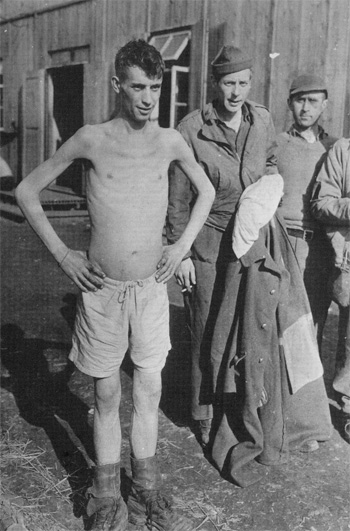
Germany, April 1945. A recently liberated American GI is ready for triage, initial treatment, and evacuation to a rear medical facility …
| Charles W. Stalder, Tec 5, 39124998 | Charles C. Starr |
| William H. Stice | Arlie E. Stipp |
| Claiborne H. Stokes, 1st Lt, MAC, O-154541 | Everett Stout |
| Gustav E. Swenson, Tec 5, 32624472 | Felix Szablewski |
| Alvin M. Taylor | Dominick A. Tedeschi |
| Harold Thomasson, Capt, DC | Harry J. Thompson |
| Albert B. Thorn | William M. Thornburg |
| Charles W. Thornton | Earl R. Todd |
| George W. Tomlinson | Edward W. Trammell |
| Michael M. Treacy, Pfc, 32401577 | Isadore A. Tuhy |
| Joseph Tumbarello, Tec 5, 32513685 | Harvey L. Turk |
| Ray F. Usry, Tec 3, 38112954 | Paul A. Uttaro |
| Louis F. Velasquez, Pvt, 32639732 | Anthony C. Vericella |
| Fred Vernon, Tec 3, 19100266 | Angelo J. Vicenzi |
| Joseph C. Viveiros, Pfc, 37206082 | Harold E. Walker |
| Roy C. Warner | Leslie L. Waters |
| Reginald T. Watts, Tec 3, 39312307 | Wilburn T. Weesner |
| Milton L. West | James W. Wharton, Pfc, 38118612 |
| Howard C. Whitmer | Orin C. Whitson |
| Harry S. Wieder | Wallace C. Wilber |
| Joseph H. Williams, Capt, MC, O-468226 | Marvin L. Williams |
| Selden T. Williams, Jr., Capt, MC, O-464767 | Melvin L. Williamson, Tec 3, 39312308 |
| Allen M. Willis | George W. Wilson |
| Gordon E. Wilson | Omer B. Wilson |
| Joseph Winkler, Pfc, 32543289 | George J. L. Wulff, Jr., Lt Col, MC |
| Bert E. Wysakowski |
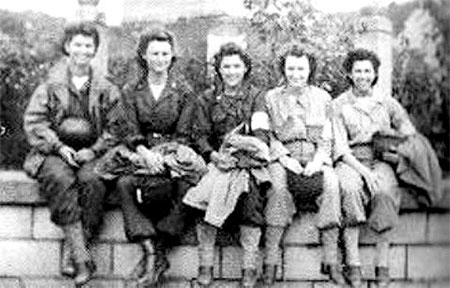
A group of ANC Officers enjoy a rest, while smiling at the camera. Germany 1945.
| Nurses: | |
| Mary E. Andrew, 1st Lt, ANC, N-760347 | Eula M. Awbrey, 1st Lt, ANC, N-728790 |
| Grace R. Boggs, 1st Lt, ANC, N-760515 | Pauline L. Byrne, Capt, ANC, N-70744 |
| Gladys E. Detwiler, 1st Lt, ANC, N-729072 | Claudia M. Draper, Capt, ANC, N-703058 |
| Sevilla M. Durkop, 1st Lt, ANC, N-728339 | Elaine Henry, 2d Lt, ANC, N-729303 |
| Frances R. Holt, 1st Lt, ANC, N-771908 | Helen M. Horvath, 1st Lt, ANC, N-728650 |
| Ann T. Jackowski, 2d Lt, ANC, N-729034 | Elizabeth T. Kramer, 2d Lt, ANC, N-728357 |
| Mary J. Maegerlein, 1st Lt, ANC, N-728416 | Freda M. Martin, Capt, ANC, N-728351 |
| Rita E. Murphy, 1st Lt, ANC, N-732956 | Mildred J. Pickett, 2d Lt, ANC, N-728810 |
| Thelma L. Raphael, 2d Lt, ANC, N-721255 | Vivian M. Robinson, 1st Lt, ANC, N-735115 |
| Rebecca Sack, 2d Lt, ANC, N-759298 | Mary E. Schreiber, 2d Lt, ANC, N-728420 |
| Mary J. Taddei, 2d Lt, ANC, N-728616 | Florence E. Thompson, 1st Lt, ANC, N-728890 |
| Nola A. Thompson, 1st Lt, ANC, N-7283 | Virginia L. Towers, 1st Lt, ANC, N-760853 |
| Eva D. Whittier, 1st Lt, ANC, N-721894 | Isle R. Williams, 1st Lt, ANC, N-729187 |
| Irene L. Yeik, 1st Lt, ANC, N-728404 | Clara R. Young, 2d Lt, ANC, N-728435 |
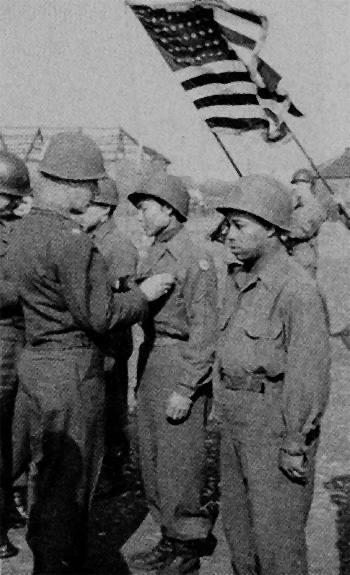
Official 12th Field Hospital awards ceremony, somewhere in Germany, May 1945.
Total Strength of Organization – 12th Field Hospital
Aggregate > 25 (1 January 1942)
Aggregate > approximately 199 (28 February 1943)
Aggregate > 226 (1 January 1944)
Aggregate > 198 (27 June 1944)
Aggregate > 184 (1 February 1945)
Aggregate > 179 (1 March 1945)
Aggregate > 181 (1 April 1945)
Aggregate > 181 (1 May 1945)
Aggregate > 176 (1 June 1945)
Aggregate > 172 (1 July 1945)
Campaign Awards – 12th Field Hospital
Normandy
Northern France
Rhineland
Central Europe
The MRC Staff are still looking for information related to the final days of the 12th Field Hospital in the European Theater and its eventual return to the Zone of Interior. A complete Personnel Roster would also be very welcome. Thank you.
